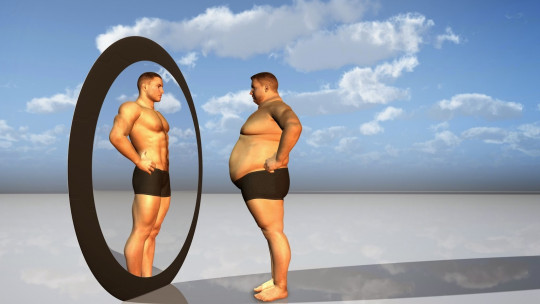
Be yourself. Do what we consider right, regardless of what others say. These two phrases may seem practically synonymous, and they often go hand in hand in such a way that thanks to their combination we can live the life we want to live, a life that is full and coherent with itself.
And yet, for many people at some point or aspect of their life, both elements can contradict each other: it is possible that a part of our being and our beliefs come into conflict. These elements or parts are considered egodystonic, a term that we are going to talk about throughout this article.
Egodystonic: definition of this term
The concept of egodystonia, from which the adjective egodystonia is based, refers to the existence of some characteristic or element which generates discomfort or discomfort to the person or people who possess it due to the fact that it contradicts or is incongruent with the values, way of being or thinking or the beliefs of said people.
As the prefix ego implies, This element contrary to one’s beliefs is part or product of one’s own being: it is a denial of the self. It generally refers to the existence of acts, attitudes, thoughts or even physical aspects performed or had by a person and that are contrary to what their system of values or beliefs admits. A cognitive dissonance is then created, a discomfort or suffering derived from the perception of the incongruity between one thought and another, and which can lead to the actions or thoughts maintained being deeply criticized internally.
This can lead to a frustrating situation that, if repeated frequently or if the disagreement cannot be expressed or resolved, will lead to experiencing stress and may even lead to some psychopathology. Thus, something egodystonic is going to be problematic as long as something is not done to make it stop being so.
The opposite concept: egosyntonic
Understanding the concept of egodystonia is much easier if we also evaluate its opposite: egotunement. Egosyntonic is defined as any thought, attribute or action possessed or carried out by a person that is congruent with the scale of values and beliefs that the person maintains.
Thus, egosyntonic is what results from following one’s own convictions: what each of us considers to be correct. The fact that our thoughts, attributes, ways of being or doing, and specific actions are ego-syntonic can mean that their existence implies well-being on an emotional level (although it may entail negative reactions or repercussions from the environment), especially if it is about something that requires us an effort. However, given that it is what we consider “should be”, it is also very common that we often do not pay attention to them (since there is no incongruity) and that they even generate indifference.
Although egodystonia obviously causes us suffering, the truth is that it has something positive: indicates that there is a dissociation between belief and situation/thought/action, in such a way that it allows us to assess the element in question and/or the beliefs behind the conflict and to be able to reevaluate them and work to achieve well-being. If he had not said discomfort, trying to change something would be difficult to say the least since there was no motivation for it.
What can cause something to be/become egodystonic?
The causes of the existence of egodystonic elements can be very variable. They may be behind the fear of living or carrying out actions or thoughts despite not wanting to do them, or the fear of being judged or the repercussions of doing something that we do want and is in line with our being.
Other possible reasons are the belief in the fusion or equation between thought and action (considering that thinking something is the same as doing it), the overvaluation of a specific act or thought in relation to a scale of values or the existence of high self-demand. Personality is another factor to take into account.
Likewise, in all or almost all cases there is also the influence of values and learning carried out culturally. Another element that can greatly affect are the upbringing and parental models, as well as the learning of behavioral models where self-criticism prevails. Obedience to authority or the effect of perceived social pressure (whether real or not) also has a great influence on whether something can be or become egodystonic.
Situations in which it may appear
Although the term egodystonic is not frequently used, the truth is that what it implies happens constantly and in a wide variety of situations and conditions. Below we indicate four examples in this regard.
1. Socio-cultural conditioning linked to sex or sexuality
Education and the sociocultural vision of things that has been transmitted to us throughout our lives can also contribute to the emergence of egodystonic elements, something especially relevant when the problem is found in elements that are part of our being.
This is the case of sexual orientation: those people with a sexual orientation other than heterosexual have traditionally seen their sexual preferences attacked and persecuted, considered sinful or unhealthy. The same occurs with those with a gender or sexual identity other than cisgender (as in the case of transsexual people), who were persecuted until not so long ago for having an identity different from the one they considered their own due to their sex at birth.
This is why some homosexual, bisexual or transsexual people, among others, may experience their sexual orientation or gender identity in an aversive and egodystonic way, as something negative and/or shameful. This means that they hide and deny a very relevant part of their being, something that can lead to the emergence of isolation and not living a free and full life, in addition to potentially leading to problems such as depression, anxiety or other psychological disorders.
2. Eating disorders
A case of mental disorder in which the existence of egodystonia can be easily observed is in eating disorders, such as anorexia and bulimia. These two disorders imply the existence of serious perceptual distortions with respect to one’s own body, as well as fear of gaining weight and reduction or alteration of intake.
Thus, for those (although less frequent) affected by this type of disorder, their own weight or body figure would be egodystonic, since it is contrary to what they would like to have.
3. Obsessive-compulsive disorder
OCD or obsessive-compulsive disorder is one of the mental disorders in which egodystonic elements appear. Specifically, the obsessive thoughts that people who suffer from this alteration have, which are defined as constantly appearing in the psyche and which are experienced as intrusive and contrary to their will, are usually totally contrary to their beliefs and values, something that makes them These thoughts are unacceptable and unattainable for the patient.
In fact, it is precisely the fact that they are egodystonic that causes them to awaken great anxiety, something that in most cases leads to compulsions to avoid them.
4. Personality disorders
Our own personality can also sometimes feel egodystonic. For example, we may have a pattern of behavior and thinking in which we are highly submissive, be very inhibited, very rigid, or have an excessive tendency to take risks. This may not be bothersome for the person, but in some cases the subject may find great unhappiness and suffering in maintaining these traits.
This may be the case of a person who is always submissive out of fear, or who needs and depends on the approval of others, but who would actually like to be more independent or not need others to feel good. In these cases we would also be facing an egodystonic characteristic. This is common, for example, in a large part of personality disorders, such as avoidant personality disorder, dependent personality disorder, obsessive disorder, borderline disorder, or histrionic disorder.
What to change?
We have said previously that egodystonia is a problem for the person unless something is done to stop it being so. In this sense, there are two main options: either the scale of values is changed in such a way that we make it congruent with the lived reality, so that what generated discomfort in us no longer does so as it is now permissible in the new way of living. see things, or the action or thought is modified in such a way that it becomes congruent with the current scale of values.
Which option to take can be complex to decide, and a large number of variables can affect it. However, we must keep in mind that we are talking about a part of our own being, so the most adaptive strategy is generally to seek to make a change in the system of beliefs and values in such a way that we can accept ourselves fully and make said part stop being egodystonic.
Thus, in the examples given, the person with egodystonic sexuality should not hide their sexuality or fight against it, but rather change the beliefs that prevent them from living it freely. In the case of anorexia or OCD, although they require treatment, it should be noted that part of the solution would be in the first case to accept one’s own body shape (something that would prevent the search for weight loss) or in the second case the having had aversive thoughts without considering them unacceptable and without the self-recrimination and guilt that it generates turning it into an obsession.
Now, sometimes what needs to be changed are acts or ways of acting that are incongruent not with our beliefs but with who or how we are. In this case, it would be advisable to make the change in the problem behavior in question. For example, a person who is excessively inhibited or submissive due to learning or imposition from others may try to train assertiveness and social skills because said inhibition is against their way of being.








